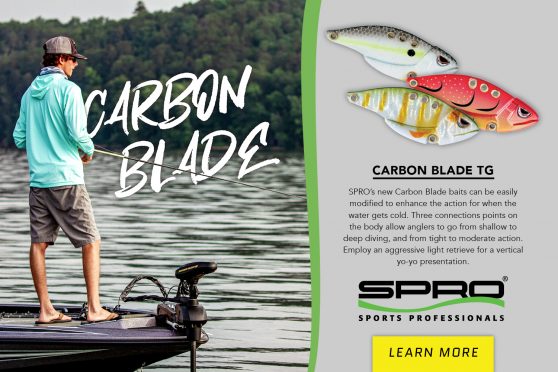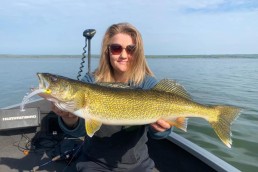Spring Walleye Strategies: Post-Spawn
SHARE THIS POST
 MidWest Outdoors editor Dave Csanda says that locating shallow structure, cover and food adjacent to walleye spawning sites are the keys to finding and catching them during post-spawn.
MidWest Outdoors editor Dave Csanda says that locating shallow structure, cover and food adjacent to walleye spawning sites are the keys to finding and catching them during post-spawn.
In the Upper Midwest, most natural lakes containing self-sustaining walleye populations are moderately clear and have a good blend of shallow and deep water. Significant main-lake flats can hold post-spawn walleyes for a time as they disperse away from spawning sites in river mouths, along rocky shorelines and atop shallow reefs. As they do, the fish encounter combinations of food and cover.
As the water warms further and the environment develops, the fish continue moving, eventually reaching the outer edges of main-lake structure bordering the basin, usually sometime in June. Here, they typically spend the rest of the year relating to various combinations of depth, cover and accessible food, according to what’s available.
The big 3: food, cover and structure
The speed at which walleyes disperse from their spawning areas depends on what lies immediately adjacent to spawning sites. Generally, if sloping flats with cover like rocks or developing weeds are nearby, walleyes will be slow to disperse, taking advantage of warmer water and relatively shallow feeding options. If the adjacent area is steep and deep with little structure or cover to hold walleyes, however, they tend to disperse rather quickly to the nearest shallow areas with food, structure and cover, rather than dropping down into deeper, colder water.
Walleyes begin to key in on baitfish that have entered the shallows in anticipation of spawning. Nearby flats with remnant or developing weeds in the 4- to 8-foot range attract yellow perch—a primary walleye forage—which deposit their eggs in sticky strings that adhere to the vegetation. Walleyes can gravitate into these areas, remaining fairly shallow amidst the weedgrowth, although they will eventually shift toward the deeper, outer edges as the water warms over the next few weeks. Until then, fish jig/plastic combos, crankbaits or slip bobber rigs with leeches atop the flats, where the best cover is located.
Various species of shiners also penetrate the shallows at this time, gathering in areas with sand/gravel bottoms in anticipation of spawning, likely near or along shore, or where current flows into the lake via creeks or channels between lakes. If there is a shallow, gradual taper beginning immediately at shore, walleyes will tend to scatter across the flats, potentially gathering areas in areas where reeds or rocks provide some sort of cover. Where the shoreline immediately drops into 3 or 4 feet of water, forming a vertical wall against which walleyes can pin schools of shiners while feeding, the fish will tend to be closer to shore—particularly at night.
Are you enjoying this post?
You can be among the first to get the latest info on where to go, what to use and how to use it!
Casting to and parallel along shoreline “walls” a primary fishing pattern on shallow prairie lakes with moderately clear to dingy water.
During post-spawn, the fish are particularly active in these areas at night, reachable by casting from shore, while wading or from a boat. Jerkbaits, rattlebaits, jig & shad-bodied tails and other shallow tactics excel. When the wind blows into these shorelines, active fish may feed here during the day as well.
North-Country flowages—aka lowland impoundments—in northern Wisconsin and Michigan tend to have fairly dark or stained water that sometimes prevents weeds from growing very deep. Three or 4 feet may be max. These lakes do, however, typically have an abundance of fallen trees, standing timber or cut stumps in shallow water.
Such areas attract post-spawn walleyes immediately after they begin dispersing from spawning areas, which could occur on gravel shoals in incoming feeder rivers, rock points or reefs in the main body of the lake, or boulders along causeways or the face of the dam. Determine a path from spawning areas to the first available suitable forms of cover, rather than fishing soft-bottom areas in the main lake. Cranks and jigs come into play, depending on whether you’re fishing relatively open water or the edges of wood cover, or pitching into it. Add slip bobbers baited with live leeches or nightcrawlers to your repertoire as well.
Want more useful walleye fishing insight? You’ll find plenty of suggestions in every issue of MidWest Outdoors, available by subscribing on our website.
MWO
SHARE THIS POST
You may also like...
Nothing found.
Did you enjoy this post?
You can be among the first to get the latest info on where to go, what to use and how to use it!
Dave Csanda
Dave Csanda has enjoyed 40 years in the fishing communications industry at In-Fisherman, Angling Edge and now, as editor of MidWest Outdoors. He is an inductee of both the Minnesota and National Fresh Water Fishing Halls of Fame.
